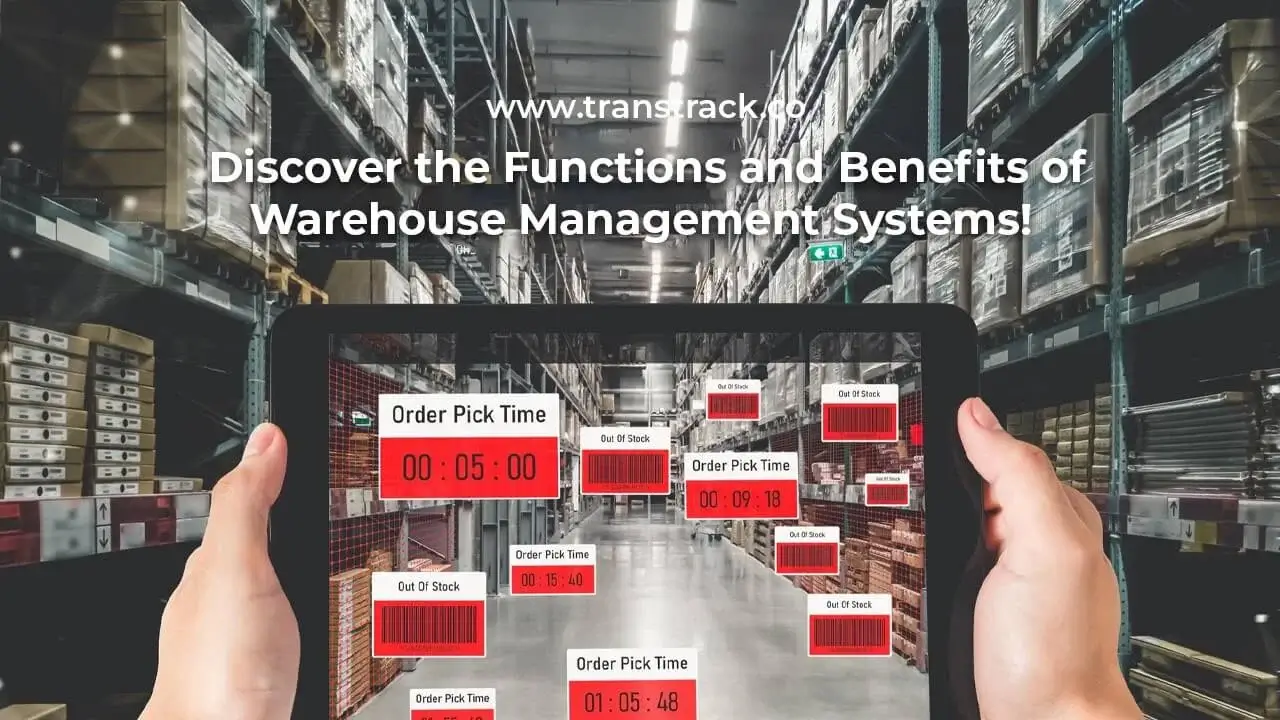Discover the Functions and Benefits of Warehouse Management Systems!
Posted on June 25, 2025 by Nur Wachda Mihmidati

The Warehouse Management System (WMS) is a system utilized to oversee all activities related to warehouse operations, including stock management, movement of goods, pick and pack management, and transportation management.
WMS enables warehouse managers to efficiently monitor and control every activity occurring within the warehouse, from receiving goods to delivering them to customers. This system provides the capability to track inventory, optimize the movement of goods, monitor shipments, manage stocks, and enhance overall warehouse operation efficiency and productivity.
WMS is typically integrated with a more extensive supply chain management system and can interact with inventory management and order management systems to ensure that warehouse stock remains optimal and available when needed. Get to know more in this TransTRACK article!
Warehouse Management Challenges in the Digital Age
Digitalization has changed the landscape of the logistics industry, including warehouse management. On one hand, technology brings greater efficiency and transparency. But on the other hand, new challenges arise that must be overcome in order for the company’s logistics system to remain competitive and adaptive to the times. The following are some of the main challenges that are often faced in warehouse management in the digital era.
1. Complex System Integration
Many companies use different systems such as ERP, TMS, and WMS. If these systems are not well integrated, data processing will be slow and operational decisions will be less accurate.
Platforms like TransTRACK can help integrate various systems through APIs so that the entire logistics and warehouse process can be monitored in one unified system.
2. Limited Inventory Visibility
Lack of real-time monitoring of inventory can lead to miscounts, stock-outs, or even lost items.
Using TransTRACK’s Asset Tracker devices and advanced sensors, companies can monitor the position and condition of goods in real time, including temperature, humidity, and vibration.
3. Human Error in Manual Process
Many companies still rely on manual record keeping, which is prone to data input errors and creates inefficiencies in the process of goods in and out.
Solution: Implementation of a digital Warehouse Management System (WMS) can reduce the risk of manual errors and improve data speed and accuracy.
4. Delays in Shipping and Receiving Process
Lack of coordination between warehouses and transportation fleets can lead to vehicle queues, loading and unloading delays, and decreased productivity.
TransTRACK’s Vehicle Scheduling & Coordination system helps organize vehicle arrival schedules to make the logistics process run more smoothly and efficiently.
5. Lack of Data for Analysis and Planning
Without historical data and performance analysis, companies struggle to make strategic decisions regarding warehouse capacity optimization and operational efficiency.
TransTRACK’s Analytics & Reporting feature provides automated and accurate reports to support data-driven decision-making.
6. Suboptimal Physical and Digital Security
The risk of physical theft and data security breaches is a serious challenge, especially when companies start relying on fully digital systems.
TransTRACK offers a combination of security systems such as CCTV MDVR, digital E-Seal for containers, as well as system-based access control for dual protection of physical assets and data.
Why Does Your Business Need a WMS?
In a fast-paced business era, warehouse management can no longer be done manually or using conventional systems. Warehouse Management System (WMS) comes as a solution to improve the efficiency, accuracy, and competitiveness of your business. Here are the reasons why WMS is an essential requirement for modern warehouse operations:
1. Greater Scale and Complexity of Inventory
The bigger your business gets, the more complex the warehouse structure and flow of goods becomes. Without an integrated system, it is difficult to accurately track the location of goods, stock status, and movement of goods in and out. WMS helps manage thousands of SKUs, storage locations, and logistics processes in real-time.
2. Demands for Delivery Speed and Accuracy
Today’s customers demand fast and precise delivery. A picking error or late delivery can damage your business reputation. WMS enables automation of picking, packing, and shipping processes, and provides full visibility of order status, improving accuracy and speeding up processing.
3. The Need for Cross-System Integration (ERP, TMS, and Others)
Warehouse operations do not stand alone, but are an important part of the logistics and supply chain ecosystem. Therefore, the WMS must be able to integrate with other systems such as ERP (Enterprise Resource Planning) for financial and production records, and TMS (Transportation Management System) for distribution and fleet management. This integration ensures seamless data flow, fast decision-making, and cost and time efficiency across business processes.
Key Features of WMS
Warehouse Management System (WMS) is designed to optimize the entire warehouse operational process, from goods receipt to delivery. Here are the key features that make WMS an essential solution in modern logistics management:
1. Real-Time Stock Tracking
WMS enables real-time and accurate stock monitoring. Every movement of goods-in, out, or movement between locations-is automatically recorded, minimizing the risk of out-of-stocks or overstocks.
2. Item Location Management
This system organizes the placement and retrieval of goods based on the most efficient storage location. With an organized location structure, the search time for goods can be shortened and productivity increased.
3. Barcode & RFID Integration
With the support of barcode and RFID technology, the process of identifying and recording goods becomes faster and more accurate. This technology also helps in stock audits and automatic asset tracking.
4. Inbound & Outbound Control
WMS systematically manages the process of receiving goods (inbound) and issuing goods (outbound). This includes document validation, quality checks, and shipment scheduling to avoid overlaps or delays.
5. Recording Warehouse Activities
Every activity in the warehouse-from checking, moving, to packing-is digitally recorded. This historical data is important for performance evaluation, reporting, and strategic planning.
How are WMS and ERP different?
Although often used together in logistics and manufacturing operations, Warehouse Management System (WMS) and Enterprise Resource Planning (ERP) have different focuses and functions. Here’s a comparison:
| aspect | WMS (Warehouse Management System) | ERP (Enterprise Resource Planning) |
| Main Functions | Manage warehouse operations such as stock, storage, and delivery | Manage all business processes such as finance, production, HR, etc. |
| Scope | Focuses on warehouse and supply chain activities | Covers all divisions and processes in the organization |
| Operational Depth | Detailed and technical, covering item location, picking/packing flow | General and strategic, not specific to warehouse operations |
| System Output | Stock data, goods movement report, warehouse efficiency | Financial reports, resource planning, business process management |
| Integration | Usually connected to ERP or TMS for complete operation | Be the integration center of all systems including WMS, TMS, CRM |
| Purpose of Use | Improve efficiency and accuracy of warehouse operations | Improve cross-departmental coordination and efficiency |
| Module Examples | Location management, inbound/outbound, barcode/RFID, stock audit | Accounting, purchasing, sales, production, HR |
Functions and Benefits of Warehouse Management System
The Warehouse Management System (WMS) is an automation system used to manage warehouse operational processes. Here is an explanation of the functions and benefits of WMS regarding several mentioned points:
Efficiency in Management Process Timeliness
WMS contributes to improving the efficiency of management processes by providing real-time information about stock levels and operational activities in the warehouse. Consequently, management can make quick and informed decisions to enhance productivity and efficiency in the warehouse.
Simplified Storage Layout Management
WMS streamlines the process of arranging and organizing the storage of goods in the warehouse. This system provides comprehensive information about the location, quantity, and types of stored goods. With this information, employees can precisely identify where items are stored, thus simplifying the retrieval and storage of goods.
Reduced Equipment Purchase and Maintenance Costs
WMS helps reduce equipment purchase and maintenance costs as it optimizes warehouse space usage and considers warehouse capacity. Consequently, companies can acquire equipment that aligns with their needs and optimize its utilization.
Enhanced Employee Performance and Productivity
WMS can boost employee performance and productivity in the warehouse because it can automate and optimize operational activities in the warehouse. As a result, employees can focus on more critical tasks such as processing goods and shortening warehouse operation times.
Improved Warehouse Inventory Accuracy and Expedited Shipping Processes
WMS can enhance warehouse inventory accuracy and expedite shipping processes by monitoring and updating the status of goods in real time. This allows companies to obtain accurate and timely information about stock levels and shorten delivery times.
Inbound Processes
WMS can optimize inbound processes or the receipt of goods in the warehouse by scheduling the receipt of goods, arranging the placement of goods in the warehouse, and monitoring stock availability.
Warehouse Processes
WMS can optimize warehouse processes by arranging the placement of goods, monitoring stock levels, and managing the efficient and precise retrieval of goods.
Outbound Processes
WMS can optimize outbound processes or the shipping of goods by considering capacity and location for picking goods, optimizing delivery routes, and updating the status of shipped goods in real time.
What Are the Benefits of Warehouse Management Systems for Businesses?
The Warehouse Management System (WMS) is a system that can help improve warehouse operational efficiency and effectiveness, offering numerous advantages for businesses. Here’s an explanation of the benefits of WMS across several points mentioned:
Speeding Up Handling Processes
WMS can enhance the speed of handling processes in the warehouse by providing real-time information about stock levels and operational activities in the warehouse. This enables companies to expedite the receipt, shipping, and retrieval of goods, thereby boosting productivity and efficiency within the warehouse.
Efficient Storage Space Management
WMS assists in efficiently and effectively managing storage space, maximizing warehouse space utilization. This can help companies reduce storage costs and optimize warehouse capacity.
Minimizing Payroll Expenses
WMS aids in minimizing payroll expenses by optimizing operational processes within the warehouse. The system efficiently and effectively allocates tasks to warehouse employees, maximizing their productivity.
Improving Customer Service
WMS can enhance customer service by expediting the shipping process and ensuring accurate stock availability. This can lead to increased customer satisfaction and bolster the business’s reputation.
Enhancing Employee Performance
WMS contributes to improving employee performance in the warehouse by efficiently organizing tasks. This allows employees to focus on crucial tasks, speeding up warehouse operations.
Reducing Company Expenditures
WMS helps reduce company expenditures by maximizing warehouse space usage and optimizing equipment utilization in the warehouse. This can aid in reducing operational costs within the warehouse and improving profitability.
Enhancing Effectiveness and Efficiency
WMS can enhance the effectiveness and efficiency of warehouse operations by providing real-time information and optimizing operational processes within the warehouse. This helps companies improve productivity and reduce operating time in the warehouse.
Elevating Customer Satisfaction
WMS can elevate customer satisfaction by expediting the shipping process, ensuring accurate stock availability, and improving service quality. This can help companies strengthen customer relationships and achieve long-term benefits.

These are the explanations regarding the benefits of the Warehouse Management System (WMS) for businesses. In optimizing the delivery of goods, companies can leverage Fleet Management System (FMS) technology like TransTRACK, which can efficiently and effectively monitor and manage vehicle fleets.
With TransTRACK, companies can obtain accurate, real-time information about vehicle locations, vehicle and driver conditions, and monitor fuel usage. This assists companies in optimizing delivery routes, minimizing operational costs, and enhancing overall operating efficiency.
Topic :
 Bahasa Indonesia
Bahasa Indonesia









